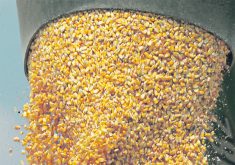Yellow pea prices are approaching an all-time high as growers head into the 2007-08 crop year, raising questions about when to sell old crop and when to lock in attractive new-crop prices.
“There are huge bids out there,” said special crops analyst Brian Clancey, editor of Stat Publishing newsletter.
Bids for No. 2 or better yellows were routinely available for $7 per bushel last week. Greens were not far behind at $6.75. Even greens with 20 percent bleached product were selling for $6 per bu.
Short crops in India, the world’s biggest importer of pulses, and Australia, one of the largest exporters, have propped up prices, but growers wouldn’t be seeing these values if it hadn’t been for the biofuel industry.
Read Also

Chinese, Indian tariffs take toll on pea prices
The disruption of pea exports from Canada’s largest customers will likely result in slow pea exports for the remainder of the crop year.
“It has fundamentally changed markets,” said Clancey.
Pea processors had to buy acres to compete with surging wheat and canola prices. With yellow peas approaching the all-time high of $7.60 per bu., it is time to consider selling what remains in the bins.
“My advice is really blunt. You need to be certain that you have sold your old-crop peas before the end of the marketing year. Do not carry them into next year,” said the independent analyst.
Growers who hold onto the old crop are banking on prices rising at least 10 percent higher than current values. That’s the opportunity cost of not having the money in their pocket right now and of watching their peas deteriorate in their bins over the summer.
The opportunity cost could be as high as 15 percent if growers have debt to pay off.
“You better be really convinced that it’s going to be over $8 per bu. a year hence in order to carry it,” said Clancey. Holding peas also adds to the 2007-08 supply, keeping a lid on next year’s pea values.
“Just get sensible. You’re making huge profits on these things. Don’t let greed get the better of you.”
Clancey offered similar advice to growers when peas hit $6 per bu. in February. That was a mistake caused by not fully appreciating how determined growers were to hold onto the crop and drive prices higher. But with the near record values being offered now, it doesn’t make sense to gamble on even better prices down the road.
Clancey also offered advice for growers mulling over attractive new-crop contracts of $6 per bu. for greens and $5.50 to $5.75 for yellows.
“No more than 25 percent of what you think you’re going to grow ought to be prepriced. It’s really dangerous to price more than that before it’s in the ground.”
If a grower books 75 percent of his expected harvest in a year when yields drop to 60 percent of normal due to drought, he may be forced to buy out the contract come fall.
A better approach is to book 25 percent at seeding and maybe sell another 25 percent if prices are still attractive in the summer when farmers have a better read on how their crop is shaping up.
One sound marketing approach is to forward contract in stages until a grower has covered his cost of production and then speculate with the profit portion of the crop.
“It’s not going to put your farm under if you speculate (and lose) with your profit, although it’s going to make your wife awfully upset about having to stay home for another winter,” said Clancey.
One thing to consider when booking new contracts is that most people in the trade are now convinced 2007 pea acreage is on the rise, contrary to the static acreage projection in Agriculture Canada’s March 12 report.
That belief was supported by last week’s United States Department of Agriculture prospective plantings report, where American growers indicated they would seed eight percent fewer pea acres than last year, nowhere close to the magnitude of decline anticipated.
U.S. chickpea plantings are projected to fall by the same percentage, while lentil acreage is forecast to drop a whopping 21 percent.















